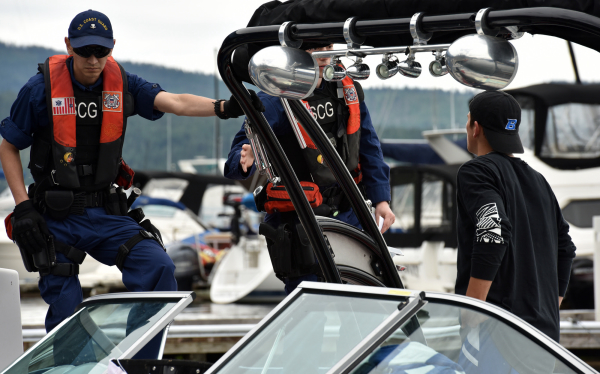
Fireworks afloat on the Fourth—what could be better? Just follow these cautions to stay safe—and avoid unpleasant encounters with the gendarmes.
While you may be decorating your boat with the Stars and Stripes and filling the cooler full of chilled beverages, marine patrol officers around the country are gearing up for the annual “Operation Dry Water”, which is aimed at those who imbibe a bit too much and become a danger at the helm.
If you boat under the influence your voyage may be terminated, the boat may be impounded and you may be treated to a free ride in the back of a patrol car.
Penalties vary by state but can include fines, jail and loss of boating or even driving privileges.
In short, it’s not a good time to stand too close to the cooler. In fact, the best bet is to wait until the boat is tied to the dock for the night before drinking alcohol, if at all. (In states where marijuana is now legal, the same cautions apply, of course.)
- The federal BAC legal limit for operating a vessel under the influence is .08.
- Alcohol use can impair a boater’s judgment, balance, vision and reaction time.
- Sun, wind, noise, vibration and motion —“stressors” common to the boating environment— intensify the effects of alcohol, drugs, and some medications.
- Alcohol use can increase fatigue and susceptibility to the effects of cold-water immersion.
- Alcohol is dangerous for passengers too. Intoxication can cause slips, falls over board and other dangerous incidents.
- If you are convicted of BWI, in some states you can have your landside driver’s license suspended.
A 150-pound man might reach .08 after 3-4 standard beers within a couple of hours, while a 150-pound woman might reach it after 2-3 beers according to the American Council on Education. Factors like body weight, metabolism, gender, and the alcohol content of the beer all play a role.

While your passengers can enjoy a few drinks while the boat is underway, the skipper needs to stay completely sober until docked.
In general, no more than one beer or wine per hour is safe in staying below the .08 BAC threshold, but smaller body size or dehydration from heat can slide this scale downward. And as all who drink are aware, even one beer per hour can affect both your judgment and your reaction times.
OK—so much for that—we are not going to drink and drive. But there are plenty of other risks in boating on a busy holiday weekend—especially after dark.
Night Boating & Fireworks
Going to see the 4th of July fireworks is awesome by boat—and you have your comfortable seating, your food and drink and your friends all right with you aboard.
However, if you’re not used to running your boat after dark, there are some things to consider.
First, if you’re an admitted novice in boat operation, it’s probably best just to watch the big show from ashore. Driving a boat after dark is a whole different deal than driving between sunrise and sunset—and it’s nothing like driving your car down the highway with a luminescent center line, abundant road signs and your LED headlights showing the way.
Instead, you’re faced with pitch black on big lakes or bays—the twinkle of houses on shore may be miles away. There will only be a partial moon visible to possibly light your way—and there could be clouds covering it completely.
Some boats have headlights, but you’re best off not to turn them on—they create night blindness, not only for you, but also for any boaters in front of you.
Obstructions—Including Other Boaters
On many waterways, there’s frequently floating debris, sometimes including large timbers and full-sized trees.
There may also be a night time catfish or crappie angler sitting out there in an unlighted jon boat, right in your path.
There are also, very likely, unlighted channel markers, as well as hopefully a few that are lighted.
If you’re getting the idea that night boating is slow boating, you’re headed in the right direction.

The USCG enforces boating rules in coastal areas and on the Great Lakes, and generally has a no-nonsense attitude about the slightest infractions. (USCG)
- Novice boaters should avoid operating after sunset, especially when considering the large crowds expected for holiday and fireworks festivities. Experienced boaters should also exercise extra precautions when operating at night.
- Make sure you know what the running lights on other boats indicate—if you see both red and green, the boat is headed right at you! If you see green and white, it’s crossing from your left and you have the right of way. If you see red and white, it’s crossing from your right and you have to slow or alter course to allow it to pass in front of you. If you see only a white light, you’re approaching from behind—or perhaps approaching an anchored boat with only it’s anchor light illuminated.
- Know and comply with approved anchoring locations issued by area marine authorities. Chart your route in advance including positions for navigation markers which may be difficult to see at night. Where possible, deploy GPS electronics to aid in navigation.
- Check in advance to ensure your boat’s running and anchor lights are working. For extra safety, carry a spotlight and flares.
- Give yourself adequate time to reach and/or return to your targeted destination. Due to reduced visibility, travel at slower speeds.
- Be patient and expect delays at busy marinas, boat ramps and docks.
- Keep your boat safely distanced from the fireworks barge, as well as from other boaters.
- Never ignite fireworks of any type including sparklers from your boat. Gas fumes from the fuel system could easily ignite.
Stay safe, stay sober, and have fun out there—it’s the Fourth of July!
— Frank Sargeant
Frankmako1@gmail.com